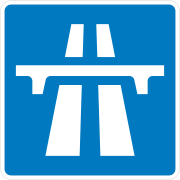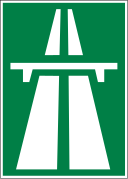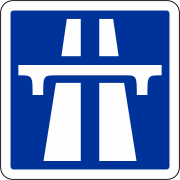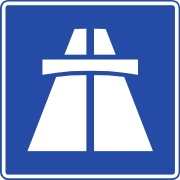Highway
A highway is a circulation path for cars and land vehicles for cargo (categorically motor vehicles) and passengers.
It must be fast, safe, and admit a considerable volume of traffic, and it differs from a conventional highway, in that the highway has more than four lanes for each direction with separate carriageways (not to be confused with the Spanish highway designed in that country in 1988). Until 2017, highways could have 2 lanes in each direction, but the term has been updated, due to the increase in the world vehicle fleet.
The first highways built in this configuration were made in Italy during the 1920s.
Among the types of roads, they represent the roads that can support the most road traffic and in which it reaches higher speeds, which is why they usually represent the main axes of the road network of a developed country (with the exception of Spain, which implemented, as a general rule, the highway in these cases).
Definition
The Organization for Economic Co-operation and Development defines highway as:
- Road specially designed and built for motorized traffic, which does not serve the farms that suit this, and that:
- (a) It is provided, except at certain points or temporarily, of a separate double road for the two senses of traffic. This separation is done by a band through which it cannot be circulated or by other means.
- (b) It has no roads that cross it at the same level, no railroads, trams or pedestrian steps or roads of any kind.
- (c) It is especially marked as a highway, and is reserved specifically for a category of motorized vehicles.
- The input and output lanes are marked for this. Urban highways are also included in the definition.
Features
In order to be classified as a highway, a road must meet the following characteristics:
- Two circulation bands, one for each sense, separated by a wide strip of land or by protective fences.
- At least two lanes of circulation in each band.
- Side clamps in each band, so a vehicle can stop in case of emergency without hindering traffic.
- Shortly pronounced curves so that vehicles do not have to slow the march by circulating them.
- Absence of crosses at level, which are resolved through higher or lower steps.
- Intersections are solved at a different level through links.
- Entrances and exits with separate lanes from the main, deceleration and acceleration, so that vehicles leaving or entering the motorway will change their speed outside of it.
- The exits and entrances are located almost always on the right side in the direction of the march, as the left lane is the forefront and therefore the fastest. The opposite for countries with transit to the left, where the exits and entrances are located almost always on the left side in the sense of the march, since the right lane is the one of advance and therefore the fastest.
- Access to properties adjacent to the motorway is not done directly from the motorway, unless entrances and exits are used as described above. In urban areas, the existence of parallel streets located on each side, called "roads of service" or "collectors", which allow access to the properties that limit with the highway without disturbing the transit of it.
Signage
History
The world's first motorway was built in Italy in 1921, between Milan and Varese. Today it is part of the Italian A8 and A9 motorways. It had two separate roads, but still did not have crosses at different levels.
The first Spanish motorway, the oldest in Spain, completed the works in 1942, corresponding to the section between the Eisenhower Junction and the Barajas airport, about 1.9 kilometers long. Not until 1952 had the old Autopista de Barajas been built with the old design of the highway that there were no lanes and only 2 carriageways were built as if it were a greatly expanded avenue.
After the first, oldest motorway in Spain, the next ones were the A-3 motorway between Madrid and Vallecas, followed by the A-6 motorway that was built between 1964 and 1967 (inaugurated this last year), between the municipalities of Madrid from Las Rozas de Madrid and Collado Villalba. The first toll road, the A-19, was built in 1969 and ran between Barcelona and Mataró. It was followed by the AP-8 (Bilbao - Behovia), AP-6 (Collado Villalba - Adanero) and "Y" Asturian A-8 / A-66 (Gijón - Oviedo - Avilés). In 1972, the AP-4, the southern motorway from Seville to Cádiz, was completed. Finally, the two main accesses to terminals 1, 2 and 3 of the Madrid-Barajas airport ended up being converted into motorways.
One of the last was the section between Benavente and Padornelo (both in the province of Zamora) of the A-52 called in its entirety as the Rías Bajas highway, and in Zamora, and the Autovía das Rías Baixas in the provinces of Orense and Pontevedra. A particular case is the A-8 Cantabrian highway, which physically becomes a highway at different points, such as the Gijón bypass.
In addition, the whole of the sections (Oviedo-Mieres), (Mieres-Pola de Lena) and (Pola de Lena-Campomanes) of the A-66, is a motorway. Also the Seville-Huelva highway (the A-49, the A-22, the northern variant of Zaragoza, the A-52 (Benavente-Padornelo) and others, although they are generally close to (or connected to) toll highways, not being the case of the latter, for example.
Spanish highways
The Spanish motorways historically follow more or less the same route that the Roman roads had in the times of Hispania. The existence of a type of road whose definition was coined in Spain, and the evolution of these over time, frequently lead to confusion, so some are listed, especially:
- A-66 Autovía Ruta de la Plata, Leon-Seville, it's not a highway.
- A-6 Northwest motorwayBenavente-Arteijo, it's not a highway.
- A-6 Northwest motorway, Madrid-Las Rozas, it's not really a highway.
- A-67 Meseta motorway, Venta de Baños-Santander, is not a motorway in the stretch that runs between Torrelavega when it dedoblates from the A-8 and to Venta de Baños.
- A-2 Nordeste motorwayFraga-Barcelona, it's not a highway.
- A-3 Autovía de ValenciaHonrubia-Valencia, it's not a highway.
- A-7 Mediterranean motorwayAs an alternative to the AP-7, it's not a highway.
- A-50 Autovía de la CulturaIt's not a highway.
- A-8 Cantabrian motorwayIrún-Baamonde, is not a motorway in the Solares-Baamonde stretch
To give some of the examples that usually generate confusion. In fact, for example, it can be mentioned that Extremadura is an autonomous community, which does not have a single kilometer of highways, not even tolls.
Differences
A highway is a type of Spanish interurban highway, doubled and high-speed, similar to the highway, although at a lower level. The mandatory guidelines for its construction and maintenance are governed by its definition in the Spanish Highway Law of 2015. On the other hand, in the field of highways, this becomes more complex, since even the definition that can be given in that The same law may come to be strongly conditioned by the international standards of the moment, especially if the motorway in question forms part of a European itinerary. In fact, frequently, it is estimated that it is because of this, together with another strong crisis at the beginning of the eighties, which could have led to this "re-design" of the highway, to maintain a national standard. Of the three sections (letters) of the OECD definition, located above, the highway, as such and by definition, is exempt from obligations in compliance with section (c), which does not imply that in some cases, it complies some of these are optional, which would explain those self-impositions on the latest generation highways. In addition, even if it reaches the point of almost doing so, the layout and its characteristics do not have to carry the same "prescriptions" than those of a highway. It is still allowed to build them on the old roads, taking advantage of them for one of the platforms, simply resurfacing them and/or widening the gauge, although at present it is only "a resource when necessary". And later painting the horizontal signaling, which does remain, if not always the same, similar to that of the highway. On a highway and a toll highway (always at the discretion of the concessionaire) it is allowed to correct potholes, speed bumps, cracks and other defects, by placing asphalt patches or by using tar pastes, on the other hand, on highways this can certainly be "crawling" and cause, de facto, that the highway becomes dangerous and changes its category to that of highway.
Cost
In transport, demand can be measured in the number of trips made or in the total distance traveled on all trips (for example, passenger-kilometres for public transport or vehicle-kilometres traveled for private transport). Bid is considered to be a measure of capacity. The price of the good (travel) is measured using the general cost of travel, which includes both money and time.
The effect of increases in supply (capacity) is of particular interest in the economics of transport (see induced demand), as the potential environmental consequences are significant (see externalities below).
In addition to providing benefits to their users, transportation networks impose positive and negative externalities on non-users. The consideration of these externalities -particularly the negative ones- is part of the economics of transport. Positive externalities of transportation networks can include the ability to provide emergency services, increased land values, and agglomeration benefits. Negative externalities are broad and can include local air pollution, noise pollution, light pollution, safety hazards, community separation, and congestion. The contribution of transportation systems to potentially hazardous climate change is a significant negative externality that is difficult to assess quantitatively, making it difficult (but not impossible) to include in transportation economics-based research and analysis. Congestion is considered a negative externality by economists.
Environmental Effects
Roads are long-term sources of linear pollution.
Road noise increases with operating speed, so major highways generate more noise than arterial streets. Therefore, considerable health effects of noise from motorway systems are expected. Noise mitigation strategies exist to reduce sound levels at nearby sensitive receptors. The idea that highway design could be influenced by acoustic engineering considerations first arose around 1973.
Air quality issues: Highways can contribute fewer emissions than arterials carrying the same volume of vehicles. This is because constant high-speed operation creates a reduction in emissions compared to stop-and-go traffic flows. However, concentrations of air pollutants near highways may be higher due to increased traffic volumes. Therefore, the risk of exposure to elevated levels of air pollutants from a road can be considerable, and is further amplified when roads are congested.
New highways can also cause habitat fragmentation, encourage urban sprawl, and allow human encroachment into previously untouched areas, as well as (counteracting) increasing congestion by increasing the number of intersections.
They can also reduce the use of public transport, which indirectly leads to more pollution.
High occupancy vehicle lanes are being added to some new/reconstructed highways in North America and other countries around the world to encourage carpooling and mass transit. These lanes help reduce the number of cars on the highway and therefore reduce pollution and traffic congestion by promoting the use of carpooling in order to use these lanes. However, they tend to require dedicated lanes on a highway, making them difficult to build in dense urban areas where they are most effective.
To address habitat fragmentation, wildlife crossings have become increasingly popular in many countries. Wildlife crossings allow animals to safely cross human barriers like roads.
Contenido relacionado
IBM S/360
Triac
Iberia (airline)






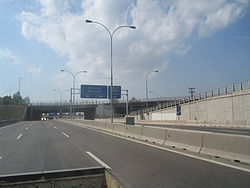


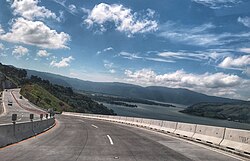

![Señal de autopista en España, Argentina y Bolivia.[4]](https://upload.wikimedia.org/wikipedia/commons/thumb/9/9a/Spain_traffic_signal_s1.svg/120px-Spain_traffic_signal_s1.svg.png)

